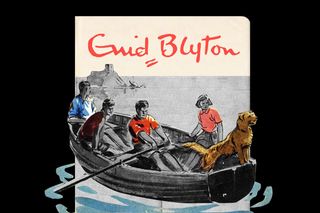
Enid Blyton Was Racist. Does That Change Our Relationship With the ‘The Famous Five’?
The author held deplorable views, but also wrote stories that changed the way children read. Both statements can be true at the same time.

Enid Blyton’s is a legacy that was challenged during her lifetime, and even after. Earlier this week, English Heritage, a British organization that sets plaques at places where famous authors lived, revised Blyton’s plaque to read: “Blyton’s work has been criticized during her lifetime and after for its racism, xenophobia, and lack of literary merit.”
The organization substantiated this with critical evidence: In The Little Black Doll (1966), the doll, Sambo, is only accepted by his owner once his “ugly black face” is washed “clean” by rain, a 1966 article notes; her story The Mystery That Never Was was refused by Macmillan in 1960 for its “faint but unattractive touch of old-fashioned xenophobia.” Even after her lifetime, the Royal Mint refused to put her face on a coin as commemoration because of her racist, homophobic past. Some depictions in Noddy and Faraway Tree series were earlier pointed out for their xenophobic sentiments.
Having our favorite authors echo statements of vitriol and prejudice feels like betrayal, especially to members of that particular community. But where does that leave creations — countless series of “The Secret Seven,” “The Famous Five,” “Noddy,” and so on — that effectively defined childhood nostalgia and imagination for many generations.
One consideration here is that all writers are products of their time. Owing to their cultural impact, however, children’s books are among those most often banned or censored.
“It is impossible to separate children’s literature from the ideological structure of our world, and from the particular historical moment in which it is produced,” Kate Cantrell and Sharon Bickle note in an article for The Conversation. This isn’t a lazy excuse to discount Enid Blyton — she had reprehensible views which have no place in today’s society. But the purpose is to show these authors were part of a socio-cultural system that has since progressed. Some of Enid Blyton’s stories have been revised since the 1990s.
Children’s books are signposts, not just to our childhoods but to how we grow up. Holding authors of our favorite books to account is thus critical.
Related on The Swaddle:
With Expiring Copyrights, Marginalized Communities Can Rewrite Fiction History
The same British organization also revised Rudyard Kiping’s plaque to read that his work reflected “racist and imperialist sentiments.” The plaque in itself is important to give more information about the writers and how their legacy stands in contrast to present values. “We need to ensure that the stories of those people already commemorated are told in full, without embellishment or excuses,” curatorial director Anna Eavis said last year. This process can exist in tandem with that of appreciating what these works of literature award us with.
The world is exclusionary, hateful, and bigoted. Blyton is perhaps complicit in furthering stigma and prejudices, like the generation she was part of. But we can still find ways to appreciate and enjoy the Mallory trees, the pursuit of adventure, the fondness of friendship. Because over time, these literary works aren’t Blyton’s only. Cultural products have split ownership: how a literary franchise cements itself in popular memory is also influenced by readers and society. Art is but what is interpreted by society.
Take the example of Harry Potter: While living in present times makes J. K. Rowling more worthy of condemnation than Blyton, both their end products are detached from the authors, which sit independently in cultural memory. With “Harry Potter,” we recalibrated our reception of the books and learned to find a balance: in critiquing Rowling for her transphobic and exclusionary views and still finding wisdom in that literature. Progress doesn’t mean we must remove what happened to get us to that point, but instead that we leave it as history and learn from it.
As Walter Benjamin once observed, children’s culture evokes what is both cherished and lost, a combination that has the potential to make us reactionary. I don’t remember which the first book I read was, but I recall it carried the characteristic cursive font with two tiny lines, the seal of five children sitting in a circle, calling themselves the Famous Five. I then jumped on to their literary neighbors, the closely knit Secret Seven gang. A whole generation of readers may perhaps relate with this; some may have known of her racist, xenophobic past, others might be witnessing the debate unfold only recently.
Our reaction here doesn’t have to exist on two extremes. “Enid Blyton had some reprehensible views (in common with many people of her time). Enid Blyton wrote some magnificent stories that helped millions of children discover a lifetime love of reading,” a journalist notes.
“It is, needless to say, perfectly fine to recognize that both statements are true.”
Saumya Kalia is an Associate Editor at The Swaddle. Her journalism and writing explore issues of social justice, digital sub-cultures, media ecosystem, literature, and memory as they cut across socio-cultural periods. You can reach her at @Saumya_Kalia.
Related


Dating Apps, Marriage Classifieds Now Allow Us To ‘Flaunt’ Our Vaccinated Status
